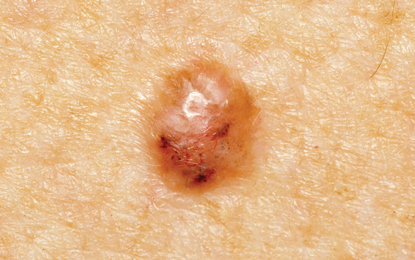MKSAP Quiz: Asymptomatic nodule
A 62-year-old man is evaluated for an asymptomatic nodule on his shoulder that has been present for more than 1 year. Skin findings are shown.

Which of the following is the most likely diagnosis?
A. Basal cell carcinoma
B. Pyogenic granuloma
C. Seborrheic keratosis
D. Squamous cell carcinoma
Answer and Critique
The correct answer is A) Basal cell carcinoma. Basal cell carcinoma (BCC) typically presents as a pearly, pink papule or nodule with telangiectatic vessels. As BCC grows, the central area often ulcerates, resulting in its characteristic rolled edge. Flecks of melanin pigment are commonly present. A biopsy is necessary, as amelanotic melanoma may have a similar appearance. Common biopsy techniques include shave or punch. Most nodular BCCs are treated with excision, whereas ill-defined lesions, high-risk histologic types, and tumors on the face and hands are treated with Mohs micrographic surgery. Selected superficial lesions can be treated with curettage, imiquimod, cryotherapy, or excision.
Pyogenic granulomas are typically bright red and friable, are commonly crusted, and develop over a few days to weeks. Removal is necessary only if the lesion is cosmetically unacceptable, painful, causes unwanted bleeding, or is otherwise bothersome.
Seborrheic keratosis is a painless, nonmalignant growth appearing as a waxy, brownish patch or plaque. Seborrheic keratoses lack a pearly appearance and typically exhibit horn cysts (epidermal cysts filled with keratin) on the surface that can best be visualized with a magnifying lens. Treatment is necessary only if lesions are symptomatic or interfere with function.
Squamous cell carcinomas are rapidly growing, hyperkeratotic, ulcerated macules, papules, or nodules that commonly appear on the scalp, neck, and pinnae. A shave or punch biopsy is used to confirm the diagnosis of suspicious lesions.
Key Point
- Basal cell carcinomas present as pink, pearly nodules with telangiectases and, commonly, flecks of melanin pigment.




